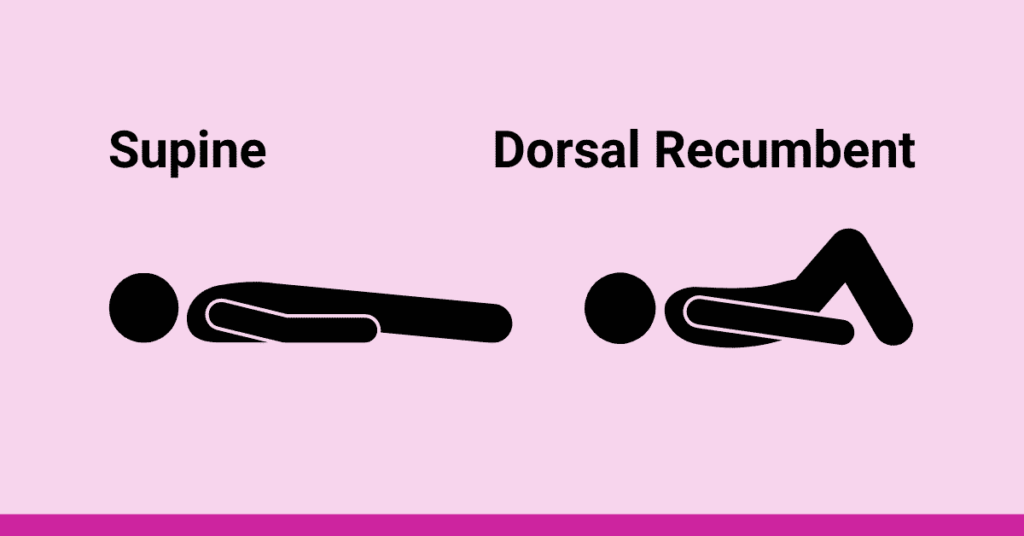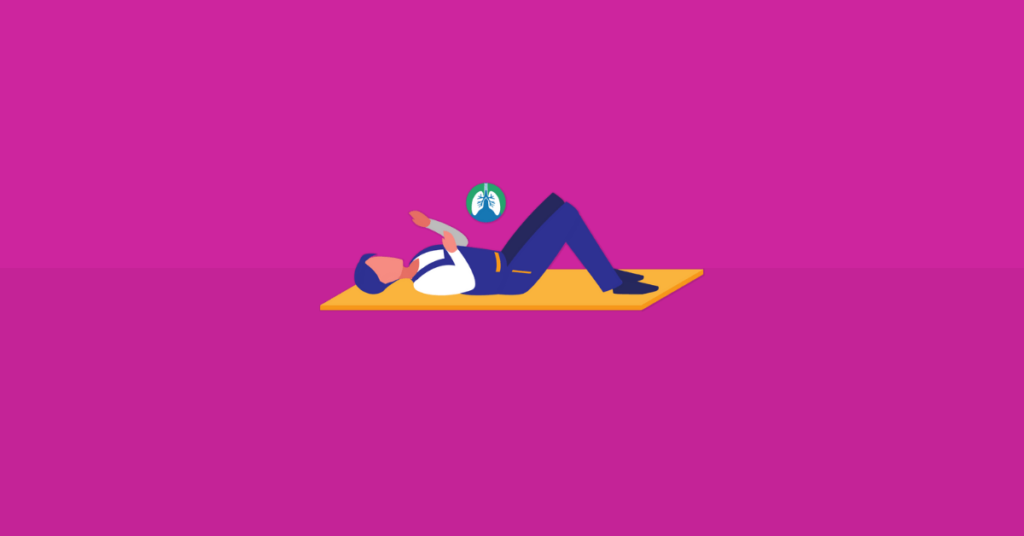The dorsal recumbent position is a commonly used position for medical examinations and procedures. In this position, the patient lies on their back with their knees bent and their feet flat on the examination table. The arms are placed at the side of the body or across the chest. This position is especially useful for examining the head, neck, anterior thorax, lungs, breasts, axillae, and heart.
One of the main advantages of the dorsal recumbent position is that it provdes easy access to the anterior part of the body. This makes it ideal for conducting physical exams, such as breast exams or cardiac auscultation. Additionally, it is often used for procedures that require access to the lower abdomen, such as pelvic exams.
However, the dorsal recumbent position may not be suitable for all patients. Patients who have breathing problems, such as those with chronic obstructive pulmonary disease (COPD), may find it uncomfortable to lie on their back. Similarly, pregnant women in their third trimester may have difficulty breathing in this position due to the pressure on their diaphragm. Elderly patients may also find it uncomfortable to lie on their back for extended periods of time.
It is important for healthcare providers to consider the patient’s comfort and safety when using the dorsal recumbent position. To minimize discomfort, pillows or blankets can be placed under the patient’s head, knees, or lower back. Additionally, healthcare providers should communicate clearly with the patient throughout the exam or procedure to ensure that they are comfortable and informed.
The dorsal recumbent position is a widely used position for medical examinations and procedures. Its advantages include easy access to the anterior part of the body, making it ideal for conducting physical exams and procedures requiring access to the lower abdomen. However, healthcare providers should consider the patient’s comfort and safety when using this position, and make adjustments as necessary to ensure a positive experience for the patient.
The Importance of the Dorsal Recumbent Position
The dorsal recumbent position is an important position used in medical examinations to provide access to various parts of the body for examination. This position allows for the examination of the head, neck, anterior thorax, lungs, breasts, axillae, and heart. In this position, the patient lies flat on their back with their knees bent and the soles of their feet flat on the examination table. This position is particularly useful for assessing the heart, as it allows the examiner to palpate the chest and feel for any abnormalities in the heartbeat. It also provids easy access to the breasts for breast examinations, and the axillae for lymph node palpation. Furthermore, the dorsal recumbent position provides a stable and secure position for patients who may be unsteady or have difficulty maintaining balance. the dorsal recumbent position is an important tool for medical professionals to perform a thorough examination of various areas of the body, providing a comprehensive assessment of the patient’s health.

Comparing Dorsal and Supine Positions
Dorsal and supine are not exactly the same. The term “dorsal” generally refers to the back of the body, while “supine” refers to a specific position in which an individual lies on their back with their face and abdomen facing upwards. Therefore, when someone is in the supine position, they are lying on their back, but being dorsal could refer to any part of the back of the body. In medical contexts, it is important to use precise terminology to avoid confusion, so while dorsal and supine are related, they are not interchangeable terms.
Inappropriate Use of the Dorsal Recumbent Position
The dorsal recumbent position is a common medical position where the patient lies on their back with their knees bent and feet flat on the surface. However, tere are certain circumstances where this position may not be suitable for the patient. Patients with breathing problems may find it uncomfortable to lie flat on their backs, as this position can make it difficult to breathe. Similarly, women in late-term pregnancies may find this position uncomfortable due to the pressure on their abdomen. Additionally, the elderly may also experience discomfort in this position due to joint problems or other medical conditions. Therefore, the dorsal recumbent position should be avoided for patients with breathing problems, women in late-term pregnancies, and the elderly.
Position of the Dorsal Side
The dorsal position, also known as the posterior position, refers to the back part of the body. This means that when an individual is in the dorsal position, they are lying on their back with their face and stomach facing upwards. In anatomical terms, the dorsal position is often used to descibe the location of various organs and structures within the body. For example, the spinal cord is located in the dorsal part of the body, as are the kidneys and the shoulder blades. The dorsal position is also commonly used in medical settings to describe certain procedures or positions, such as the dorsal lithotomy position used during gynecological exams. the term dorsal is a crucial part of anatomical and medical terminology, as it helps to accurately describe the location of various parts of the body.
The Difference Between Dorsal Recumbent and Supine Positions
Dorsal recumbent and supine positions are often used interchangeably, but there is a slight difference between the two. In the dorsal recumbent position, the patient lies flat on ther back with their legs bent and their feet flat on the bed. The arms are usually resting at the sides. In contrast, in the supine position, the patient also lies flat on their back, but their legs are usually extended or slightly bent, and their arms can be positioned either up or down. The head and shoulders are slightly elevated using a pillow in both positions, unless contraindicated. the difference between the two positions is the position of the legs, as the dorsal recumbent position involves bent legs while the supine position can have extended or slightly bent legs.

Placing a Patient in Dorsal Recumbent Position
To properly position a patient in the dorsal recumbent position, the nurse should follow these steps:
1. Explain the procedure to the patient and ensure they are comfortable with the position change.
2. Have the patient lie on their back on the bed with their legs straight.
3. Bend the patient’s knees and place their feet flat on the bed.
4. Instruct the patient to lift their hips and slide their body towards the top of the bed.
5. Ask the patient to relax their legs and let their knees fall apart.
6. Place a pillow or rolled blanket under each knee to support them and maintain the position.
7. Ensure the patient’s arms are comfortably at their sides or resting on their abdomen.
8. Verify that the patient is comfortable and in a stable position before leaving them.
It’s important to note that the nurse should use proper body mechanics and ask for assistance if needed to prevent injury to temselves or the patient.
The Seven Anatomical Positions
The sevn anatomical positions are important terms used to describe the relative positions of different parts of the body. These positions include superior, inferior, anterior, posterior, medial, lateral, and proximal. Superior refers to a position that is closer to the head or higher up, while inferior is a position that is closer to the feet or lower down. Anterior refers to the front of the body, while posterior refers to the back. Medial refers to a position closer to the midline of the body, while lateral refers to a position further away from the midline. proximal refers to a position that is closer to the center of the body or the point of attachment, while distal refers to a position that is further away from the center or point of attachment. These terms are essential for understanding the structure and function of the human body, and are commonly used in medical and scientific contexts.
The Four Main Anatomical Positions
The four main anatomical positions are the supine position, prone position, rght lateral recumbent position, and left lateral recumbent position. In the supine position, the person lies on their back with their face and upper body turned upwards in a horizontal position. The prone position is the opposite of the supine position, with the person lying on their stomach with their face down. The right lateral recumbent position involves lying on the right side of the body, while the left lateral recumbent position involves lying on the left side of the body. It is essential to note that each of these positions has different medical implications and is used in various medical procedures. For instance, the supine position is commonly used during surgeries and examinations of the chest and abdomen. In contrast, the prone position is used in certain spinal surgeries and procedures. Understanding the different anatomical positions is crucial in medical practice to ensure proper patient positioning and avoid complications.
What Is the Medical Term for Dorsal?
Another medical term for dorsal is posterior. It refers to the back side of the body or any structure that is located towards the back. The term is often used in anatomy and medical fields to describe the location of bones, muscles, nerves, and other body structures. For instance, the shoulder blades are located on the posterior side of the body. Understanding medical terms like dorsal or posterior is important for healthcare professionals to communicate effectively with one another and describe the location and function of various body parts.
Positioning for Respiratory Distress
The best position for a patient in respiratory distress depends on the underlying cuse of their distress. However, in general, the position that is most effective in improving breathing and oxygenation is the upright position. In this position, the patient is sitting up and leaning forward slightly, with their arms supported on a table or pillows.
This position helps to reduce the pressure on the lungs, allowing the lungs to expand more fully and making it easier for the patient to breathe. It also helps to improve the ventilation-perfusion ratio, which is the balance between the amount of air reaching the alveoli (tiny air sacs in the lungs) and the amount of blood flowing through the pulmonary capillaries.
However, if the patient is unable to maintain an upright position due to weakness or other medical conditions, other positions may be used. For example, in some cases, the patient may be placed in a semi-upright position with the head of the bed elevated, or in the prone position (lying face down) if they require mechanical ventilation.
Ultimately, the position that is best for a patient in respiratory distress should be determined by a healthcare professional based on the patient’s individual needs and medical history.
Positioning a Victim in the Recumbent Position
The recumbent position, or lying down flat on their back, is not typically recommended for a victim who is unconscious or experiencing a medical emergency. This is because it can cause their tongue to fall back and block their airway, leading to difficulty breathing or even suffocation. Instead, a victim should be placed in the recovery position, which involves lying them on their side with their head tilted back slightly and their top leg bent at the knee to support their body. This position helps to keep their airway clear and open, ensuring that they can breathe properly. It also allows any vomit or fluid to drain out of their mouth, reducing the risk of choking. The recovery position is recognized as the standard first aid position for unconscious victims or thoe who are unable to maintain their own airway.
The Meaning of Recumbent Position
The recumbent position refers to the body’s position when it is lying down horizontally, with the backrest on a flat surface. This position is commonly associated with sleeping or resting, and it is often used in medical settings for patients who require extended periods of bed rest. The recumbent position is characterized by the body being in a straight line, with the head, torso, and legs all lying flat on the surface. This position can be beneficial for reducing pressure on the spine and promoting better circulation throughout the body. Additionally, the recumbent position can make it easier for individuals to breathe and can aid in the healing process for cetain medical conditions. the recumbent position is an important concept to understand in the context of sleep, rest, and medical care.
What Are Examples of Dorsal?
Dorsal refers to the position of a body part that is located on the upper side or back of an organism. In vertebrates, the dorsal part of the animal is where the backbone is located. For instance, the dorsal fin of a fish is the fin located on its back, wheras the ventral fin is located on its underside. In humans, the back is the dorsal side of the body, and the chest and abdomen are ventral.
Other examples of dorsal structures in animals include the dorsal fin of whales, sharks, and dolphins, the dorsal shell of a turtle, and the dorsal spine of a porcupine. In plants, the dorsal side refers to the side of the leaf that is facing upwards, away from the stem.
Dorsal refers to the upper side or back of an organism, and examples of dorsal structures can be found in both animals and plants.
The Benefits of the Ventral Recumbent Position
Ventral recumbency is a position in which an animal lies on its abdomen with the belly facing downwards. In this position, the animal’s legs are extended outwards and its head may be turned to one side. This position is commonly used in veterinary medicine for procedures such as abdominal surgery or ultrasound imaging of the abdominal organs. It is also used during physical examinations to assess the animal’s abdominal organs, such as the liver, spleen, and intestines. Ventral recumbency is an important position for veterinarians to know and understand, as it allows for btter visualization and access to the animal’s abdominal area.

Conclusion
To conclude, the dorsal recumbent position is a fundamental position used in medical examinations to examine the head, neck, anterior thorax, lungs, breasts, axillae, and heart. The position requires the patient to lie flat on their back, facing upwards, with their knees bent and feet flat on the examination table. The position enables the examiner to assess various parts of the body more efficiently, including the respiratory, cardiovascular, and lymphatic system, and is particularly useful for pelvic exams. However, it may not be suitable for patients with breathing problems, late-term pregnancies, or the elderly. Understanding the significance of this position and its application can help healthcare professionals to proide better diagnoses and treatment plans for their patients.
